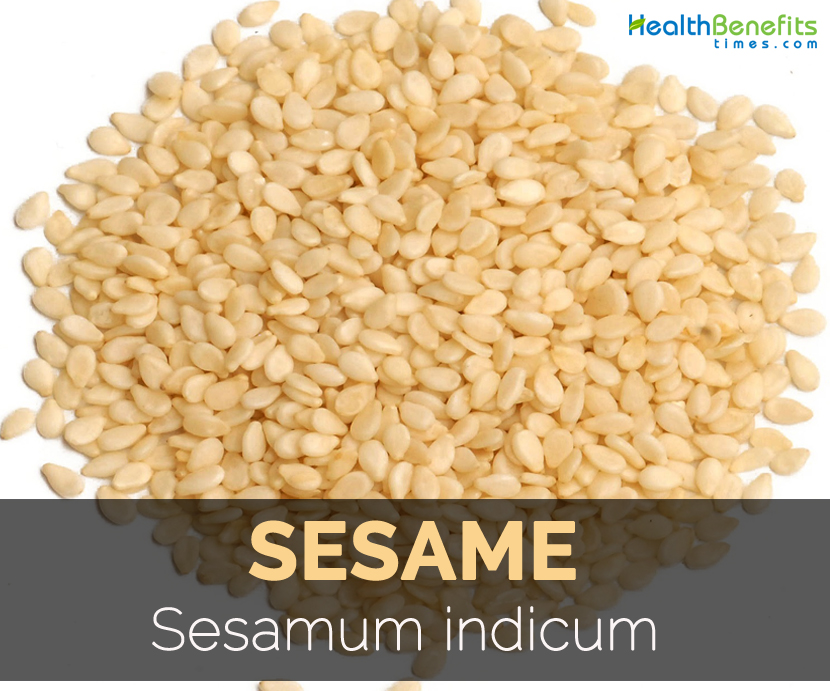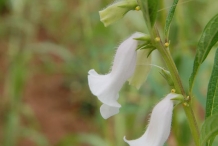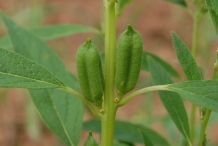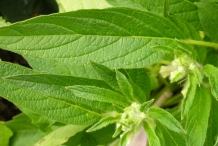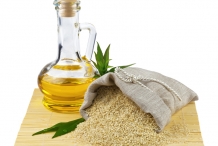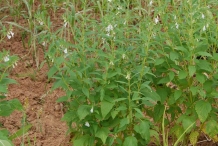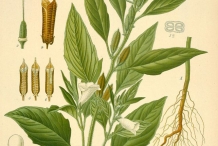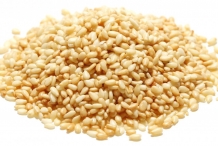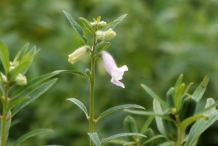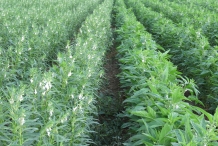When the plant reaches at maturity the stems and leaves turns to red from green and yellow. Though the flowers are self-pollinated, insects do the crosspollination which is common. Each plant delivers about 15 to 20 fruits that consist of 70 to 100 seeds. Due to the high resistance to rancidity and oxidation, it is called Queen of Oilseeds. The color of the flower ranges from white, purple, blue, gray, red, brown, tan, buff, gold to black. White Sesame Seeds, Brown Sesame Seeds and Black Sesame Seeds are the varieties of Sesame seeds.
History
Sesame plant is considered as the oldest cultivated plants found in the world. It is highly appreciated oil crop of Assyria and Babylon about 4000 years ago. Currently, China and India are regarded as the largest producers of Sesame in the world displaced by Sudan, Myanmar, Mexico, Venezuela, Nigeria, Uganda, Turkey and Ethiopia.
It adapts well in tropical regions and is widely cultivated for its edible seeds. In 2013, about 4.2 million metric tonnes of Sesame seeds was harvested by considering China and India as the greatest producers. It is believed that Chinese used Sesame oil in the lamps before 5,000 years ago. Some believed that the Sesame seeds were introduced about 2000 years ago in China. During the late 17th century, Sesame seeds were brought from Africa to the United States. China, Mexico and India are the highest producers of Sesame seeds commercially.
Plant
It is an annual plant which is occasionally perennial and grows upto 0.5-1.5 m in height. The plant is highly branched or unbranched that depends upon the variety. The simple leaves are 7.5-12.5 cm, alternate, ovate, oblong or lanceolate and toothed. The flower appears on Mid-Summer or Late Summer/Early Fall. Flowers are bell shaped, hermaphrodite, white, pink or mauve pink which develops on the leaf axils. The flowers are turned into a capsule which is a fruit that is oblong to quadrangular, compressed and 1.5-5 cm long. Each fruit bears 50 to 100 seeds or more that are black, white, brown; 2.5-3 mm long; 1.5 mm wide and 1 mm thick of egg shaped. The seeds weigh about 20 and 40 mg.
Nutritional Value
144 grams of Sesame seeds provides 653.11% of Copper, 261.88% of Iron, 204.34% of total fat, 154% of manganese, 140.40% of calcium, 129.43% of phosphorus, 127.05% of tryptophan, 120.24% of magnesium, 101.45% of zinc, 94.92% of Vitamin B1, 90% of Selenium, 87.54% of Vitamin B6, 67.52% of valine, 65.73% of isoleucine, 61.04% of histidine, 60.23% of threonine, 52.92% of leucine, 51.06% of protein, 44.74% of total dietary fiber, 40.64% of niacin, 35% of folate, 27.38% of Vitamin B2, 25.98% of carbohydrate, 24.49% of lysine and 14.34% of potassium.
Health Benefits of Sesame
Sesame seeds are a great source of manganese, copper, magnesium, calcium, Vitamin B1, phosphorus, molybdenum, zinc, dietary fiber and selenium. Additionally, sesame seeds possess sesamolin and sesamin which helps to lower the cholesterol in humans and also prevents high blood pressure. It was used for over 5000 years. It could be added to the culinary uses. They possess curative, preventive and nutritive properties. It helps to cure the health ailments such as low blood pressure, diabetes, cancers, sleep ailments, inflammation, oral problems, detoxification, depression, chronic stress, enhance circulation, healthy growth, respiratory health, heart health and prevents from radiation.
- Health problems
Sesame seed possess sesamin which is furofuran lignin that is oil soluble. The study made on rats shows that it helps to lower the cholesterol level, normalize blood pressure, results weight loss and prevents liver. Sesamin biosynthesis contains two main genes piperitol/sesamin synthase and encoding dirigent protein. The researchers evaluated that homologues of DIR was found in tomato and sesame and PSS was also discovered in sesame which indicates the foundation of genetic for the sesame product. (1)
- Promotes cholesterol
The rice bran oils and blend of sesame helps to reduce the blood pressure and promote the cholesterol levels. Sesame oil has low saturated fat that helps to enhance the cholesterol level of the patients. It lowers the chances of heart disease. Antioxidants and healthy fatty acids such as sesamolin, sesamol, oryzanol and sesamin help to provide the effective results. The earlier studies show that antioxidants and mono & poly unsaturated oils is associated with reducing blood pressure as well as total cholesterol. (2)
- Prevents E.coli
The diet rich in sesame helps to prevent the infection of gastro intestines and lower the symptoms severity caused due to Salmonella or E.coli. Tomato, yeast and pumpkin are the other foods that provide these beneficial effects. The extract of sesame seed and konjac gum helps to prevent Salmonella and E.coli onto the host from latching. The fiber helps to maintain the healthy digestion and gut. (3)
- Maintains blood pressure
Sesame seeds have natural oils that help to lower hypertension, strain of cardiovascular system and prevent the cardiac ailments. Moreover, magnesium acts as a vasodilator. Sesame seeds are loaded with minerals about 25% of daily requirement.
- Prevents cancer
Sesame seeds contain various minerals and vitamins that help to lower the chances of cancer. It also have phytate, which is a compound that prevents cancer and acts as an antioxidant which helps to reduce the activities of free radicals that are the harmful byproducts of cellular metabolism and leads to the health ailments such as premature aging, heart disease and cognitive malfunctions. Sesame seeds are associated with the prevention of lung, breast, leukemia, colon, pancreatic and prostate cancer. (4) (5)
- Manage diabetes
Sesame seeds are the great source of magnesium that helps to lower the risk of diabetes and manage the health conditions. Additionally, the oil of Sesame seeds has positive effect on the diabetic medications such as glibenclamide in the Type 2 diabetic patients. It helps in the regulation of glucose and insulin levels and also manages the diabetic symptoms.
- Healthy bones
Sesame seeds have ample amounts of minerals such as calcium, zinc and phosphorus that help to enhance the bone health. The minerals are vital parts for the development of bones, repairmen of bones which may get weak due to injury and chances of osteoporosis. (6)
- Assist digestion
Sesame seeds are loaded with adequate amounts of fiber which is essential for the healthy digestion. It adds bulk to the movements of bowel and makes the movement efficient from the digestive tract. It helps to lower the problems such as diarrhea, constipation, prevent the colon health and lower the risk of cancer and gastrointestinal diseases. It helps to lower the bad cholesterol from blood vessels and arteries and also prevents heart attacks, atherosclerosis and strokes. (7)
- Reduce inflammation
Sesame seeds help to lower the inflammation in bones, muscles and joints and also lower the pain caused due to arthritis. Additionally, copper helps to strengthen the walls of blood vessels, joints and bones. Copper is essential for the iron uptake which is vital for the hemoglobin. The adequate amount of copper assist circulation and transports oxygen in the body for the functioning. (8)
- Protects radiation
Sesamol is an organic compound that is found in the sesame seeds and helps to prevent DNA from the radiation effects. This radiation could arise from the cancer treatment with radiotherapy and chemotherapy. It helps to prevent the mutation of DNA. The sesame seed helps to enhance the strength and lower the chances of cancer caused because of the mutation of cells. (9)
- Hair and skin health
Sesame seeds have adequate amount of zinc which is essential for the collagen formation, strengthening hair, muscle tissue and skin. The oil extracted from Sesame seeds helps to lower the presence of skin marks and burns and also lowers the chances of premature aging.
- Metabolic functions
Sesame seeds are rich in protein which is broken down into usable proteins in the human body. It promotes the healthy growth of cells, overall strength, energy levels, mobility and metabolic functions. (10)
Traditional uses
Arabic countries:
- The dried seeds are used as a plaster in Unani medicine.
- The seed oil is used to prevent conception on the glans penis before coitus.
China:
- The hot water extract made from seed is used for impotence.
- The seed oil is used to cure tuberculosis.
Cuba:
The oil extracted from seeds is used as galactogogue.
Europe:
The seed oil is used orally as an emmenagogue.
Haiti:
The decoction made from dried seeds is used for asthma.
India:
- The oil extracted from seed oils is used as purgative.
- The grounded leaves with jaggary are consumed with coconut milk to cure rabies.
- The leaf infusion helps to control diabetes.
- The leaf decoction made with 25 to 30 dried leaves if used for 6 months helps to regulate diabetes.
- The seeds extract is used as abortifacient and emmenagogue.
- The hot water extract made from dried seed helps to promote hair and treat ulcers, eye diseases, piles and biliousness.
- The fresh oil of seeds is used to treat eye ailments.
Ivory Coast:
The juice extracted from new leaves is used to discharge placenta.
Jordan:
The oil extracted from seeds helps to persuade lactation and acts as an antitussive.
Malaysia:
The seed oil is used by males for sexual neurasthenia as a tonic.
Mexico:
The grounded seeds are mixed with masa and consumed for enhancing milk flow in the nursing mothers.
Morocco:
Seeds are consumed as stimulant, hypnotic and stimulant for lactation.
Mozambique:
Orally, the juice of plant is used as an aphrodisiac.
Nepal:
The seed oil spread over umbilicus and about 3-5 ml is placed inside ostium which is used as an abortifacient.
Pakistan:
The seeds are used as an emmenagogue.
Peru:
The hot water extract made from dried bark is orally used for chest pains, dislocations and contusions.
Saudi Arabia:
The hot water extract made from dried plant is used as a contraceptive in 13th century.
South Africa:
The hot water extract made from leaves is orally used by Transvaal Sotho as an aid for malaria.
South Korea:
- The hot water extract made from seed is orally used to promote menstruation.
- The hot water extract made from dried seed is used as an emmenagogue and abortifacient.
United States:
- The seeds (dried) are consumed as an emmenagogue.
- The hot water extract made from seed oil is orally used to encourage menstruation.
Vietnam:
The seed oil is orally used as an emmenagogue.
African medicine:
- In traditional Egyptian remedy, Sesame oil is used for circulatory disorders, nerve pain, arthritis, neuralgia and clear away extreme earwax.
- Traditionally, it is used for the preparation of perfume.
- In Nigeria, the leaf extracts of Sesame leaf helps to treat skin disorders like infections.
- Leaves of Sesame are used in Ivory Coast of West African country as an aid for childbirth.
Ayurveda:
- Sesame oil helps to treat various chronic ailments such as diabetes, liver disorders and migraines.
- The Sesame oil is applied to the hair which helps to prevent hair loss and hair graying.
Caribbean medicine:
- Traditionally, Sesame oil is used in Cuba for purported galactogogue properties.
- In Haiti, the decoction made from dried sesame seeds helps to treat colic or asthma.
East/Southeast Asian and Chinese medicine:
- Dried flowers of Sesame are used in traditional Chinese medicine as a cure for alopecia, constipation, frostbite and warts.
- The grounded seeds of Sesame are used topically to cure skin burns and insect bites.
- The poultice of Sesame is used by the Chinese to treat skin disorders, and joint disorders.
- The Sesame seeds help to prevent hair loss.
- Sesame helps to enhance the function of liver.
European medicine:
In Western European countries, Sesame is used as a laxative for the treatment of dysentery.
Latin American medicine:
In Venezuela, Sesame is used to treat cough.
Middle Eastern medicine:
- Sesame oil is used to provide relief from throat soreness, dryness and as a moisturizer for the cracked lips.
- In Nepal, Sesame oil is used as an alternative for mustard oil to massage newborns.
Others:
- Its internal use is used to treat hair greying, hair loss, chronic dry constipation, convalescence, dental caries, stiff joints, osteoporosis, dry cough etc.
- Its external use is useful for ulcers and haemorrhoids.
- The oil if mixed with lime water helps to treat boils, burns and ulcers.
- The root decoction helps to treat coughs and asthma.
- The fresh leaves and seeds are used as a poultice.
- Sesame seeds are also used to cure piles.
- The Sesame seeds help to treat respiratory disorders.
- In aromatherapy, Sesame oil is used as body massages.
- Sesame oil also treats gum and teeth ache.
How to Eat
- Seed are cooked, roasted or stewed.
- Seeds are grounded into powder which is used as flour and added to vegetables, breads and sweetmeats.
- The grounded powder is mixed with sweetener for making halva or made as a paste which is used as a spread “tahini”.
- The sprouted seeds are used in salads.
- The raw or cooked leaves are used as a potherb and also added to soups.
- Young leaves are added to stews.
- Sesame seeds are used as an ingredient in numerous cuisines.
- In Greece, seeds are used to make cakes as well.
- In Asia, Sesame seeds are used on sushi style foods.
- Sesame oil is used to add the flavor of pickles, spicy foods and condiments.
- In Japanese cuisine, goma-dofu is prepared from starch and sesame paste.
- Sesame seeds are added to bread, cookies and muffins.
- Sesame seeds are used as a touch for steamed broccoli which is sprayed with lemon juice.
- Spread sesame paste on a toasted bread or honey could be drizzled for a sweet treat.
- The toasted Sesame seeds could be combined with soy sauce, rice vinegar and crushed garlic and used as a dressing for salads, noodles and vegetables.
- Mix the toasted Sesame seeds and vegetable oil with light brown paste “tahini”.
- Toasted seeds are spread over sandwiches, cakes, biscuits, stir fries, etc.
- The seeds are mixed with almonds, roasted peanuts and jaggery.
Precautions
- Unhealthy Weight:
Sesame seeds are loaded with saturated fat and calories. The serving size of 100 gm of Sesame seeds contains only 590 calories. It also provides saturated fat (8 gm) which is about 40% of the daily intake. The addition of Sesame seeds in the diet may lead to unhealthy body weight.
- Colon Cancer:
The daily intake of Sesame seeds in excessive amounts may affect the colon. The researchers shows that the intake above 15 nanograms of Sesame seeds regularly affects colon which leads to the fatal diseases such as colon cancer. It is considered as one of the harmful side effects of Sesame seeds that can result to death.
- Diverticulitis:
Sesame seeds can cause diverticulitis by affecting the colon health. It is a medical condition that forms severe painful pouches in the colon’s inner wall. It could lead to cramping, constipation, abdominal pain, and others.
- Allergic Reactions:
Allergy is the other side effects that could be faced with an intake of Sesame seeds. It may cause the allergies such as digestive issues, runny nose, eye inflammation and asthma in sensitive people.
- Anaphylaxis:
It is an allergy that is caused due to the consumption of Sesame seeds. It affects the whole body due to the allergic reaction. It may cause wheezing, chest tightness, hypotension etc. It also leads to the blockage of throat and airway so one could suffer from suffocation that leads to death.
- Infection of Appendix:
Some people might experience the appendix infection by consuming extreme Sesame seeds. The seeds might get stuck in organ which might lead to the serious to mild infections.
- Diarrhea:
Sesame seeds possess the laxative properties. The high intake of kernels results in diarrhea and loose stool. One should consume it in limited amounts.
- Skin Rashes:
Sesame seeds might have negative effects on skin. The high intake of the foods rich in Sesame seed oil could develop skin rashes such as redness and itching.
- Hair Loss:
The black sesame seeds are used to ensure the hair health. But the overuse of it could have adverse reactions. It cause imbalance of hormones that leads to oily scalp and dries hair follicles. Therefore, it might leads to high rate of hair fall. It might lead to baldness as well.
- Miscarriage:
The intake of Sesame seeds during the pregnancy of first trimester is harmful for the health because it may cause miscarriage.
http://www.stylecraze.com/articles/serious-side-effects-of-sesame-seeds/
Other Facts
- The largest importer of Sesame in the world is Japan and China is the second.
- Canada, United States, Turkey, Netherlands and France are the other major importers.
- Seeds are regarded as emollient, tonic, nourishing, lactagogue and diuretic.
Types of Sesame Seeds
Sesame seeds come unhulled or hulled in various colors. It contains nutritions and minerals such as manganese, copper, calcium and iron. It is used as a topping for breads, vegetables, desserts and pastas.
1. Hulled Vs. Unhulled
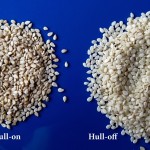 Sesame seeds could be unhulled or hulled. The products formed from unhulled seeds such as butter and tahini paste are darker and bitter in comparison to kernel. The hull has more calcium (51 milligrams more) in comparison to seed. Unhulled seeds should be preserved in an airtight, cool as well as dry environment. Hulled seeds could turn rancid. It should be refrigerated or frozen.
Sesame seeds could be unhulled or hulled. The products formed from unhulled seeds such as butter and tahini paste are darker and bitter in comparison to kernel. The hull has more calcium (51 milligrams more) in comparison to seed. Unhulled seeds should be preserved in an airtight, cool as well as dry environment. Hulled seeds could turn rancid. It should be refrigerated or frozen.
2. Black sesame seeds
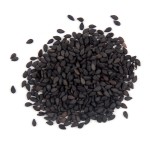 The seeds of Black sesame has a bold flavor. The seeds possess antioxidant and therapeutic properties. It is used to provide flavor to baked goods. The powder is used on the rice dishes such as Tarladalal. This sesmae seed is used to make the oil of highest quality. It is occasionally used as the nut alternatives.
The seeds of Black sesame has a bold flavor. The seeds possess antioxidant and therapeutic properties. It is used to provide flavor to baked goods. The powder is used on the rice dishes such as Tarladalal. This sesmae seed is used to make the oil of highest quality. It is occasionally used as the nut alternatives.
3. White sesame seeds
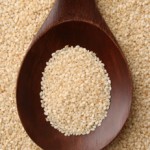 The white sesame seeds are used in breads and buns. The powdered form of White sesame seeds are used in curry sauces, rice and chutneys. The toasted White sesame seeds are used in sushi rolls.
The white sesame seeds are used in breads and buns. The powdered form of White sesame seeds are used in curry sauces, rice and chutneys. The toasted White sesame seeds are used in sushi rolls.
References:
http://davesgarden.com/guides/pf/go/81666/
https://npgsweb.ars-grin.gov/gringlobal/taxonomydetail.aspx?id=33749
http://www.pfaf.org/user/Plant.aspx?LatinName=Sesamum+indicum
http://scholarsresearchlibrary.com/dpl-vol8-iss6/DPL-2016-8-6-328-334.pdf
http://www.home-remedies-for-you.com/herbs/sesame.html
https://en.wikipedia.org/wiki/Sesame
http://www.eatrightontario.ca/en/Articles/Food-allergies/intolerances/Facts-on-sesame-allergy.aspx
http://www.agr.unizg.hr/smotra/pdf_75/acs75_23.pdf
https://en.wikipedia.org/wiki/Sesame
http://www.whfoods.com/genpage.php?tname=foodspice&dbid=84
http://www.nutrition-and-you.com/sesame-seeds.html
https://www.organicfacts.net/health-benefits/seed-and-nut/sesame-seeds.html
Comments
| Sesame Quick Facts | |
|---|---|
| Name: | Sesame |
| Scientific Name: | Sesamum indicum |
| Origin | Native to Africa and India |
| Colors | Black, white, brown (Seed) |
| Shapes | Length: 2.5-3 mm; Wide: 1.5 mm; 50 to 100 seeds or more; Thickness: 1 mm; egg shaped (Seed) |
| Calories | 825 Kcal./cup |
| Major nutrients | Copper (653.11%) Iron (261.88%) Total Fat (204.34%) Manganese (154.00%) Calcium (140.40%) |
| Health benefits | Health problems, Promotes cholesterol, Prevents E.coli, Maintains blood pressure, Prevents cancer |
| More facts about Sesame | |
| Rank | Scientific Name & (Common Name) |
|---|---|
| Kingdom | Plantae (Plants) |
| Subkingdom | Viridiplantae |
| Infrakingdom | Streptophyta (Land plants) |
| Superdivision | Embryophyta |
| Division | Tracheophyta (Vascular plants, tracheophytes) |
| Sub division | Spermatophytina (Spermatophytes, seed plants, phanérogames) |
| Class | Magnoliopsida |
| Superorder | Asteranae |
| Order | Lamiales |
| Family | Pedaliaceae (Pedaliums) |
| Genus | Sesamum L. (Sesame) |
| Species | Sesamum indicum L. (Sesame) |
| Synonyms |
|


